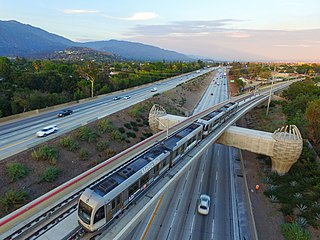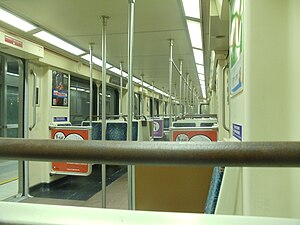
Hyundai Rotem Co. is a South Korean company that manufactures rolling stock, defense products and plant equipment. It is a part of the Hyundai Motor Group. Its name was changed from Rotem to Hyundai Rotem in December 2007 to reflect the parent company. It is also called Hyundai Railroad Technology Systems.

Muni Metro is a semi-metro system serving San Francisco, California, United States. Operated by the San Francisco Municipal Railway (Muni), a part of the San Francisco Municipal Transportation Agency (SFMTA), Muni's light rail lines saw an average of 75,500 boardings per day as of the fourth quarter of 2023 and a total of 24,324,600 boardings in 2023, making it the sixth-busiest light rail system in the United States.
Hitachi Rail Italy S.p.A. is a multinational rolling stock manufacturer company based in Pistoia, Italy. Formerly AnsaldoBreda S.p.A., a subsidiary of state-owned Finmeccanica, the company was sold in 2015 to Hitachi Rail of Japan. After the deal was finalized, the current name was adapted in November 2015 to reflect the new ownership.

The B Line is a fully underground 14.7 mi (23.7 km) rapid transit line operating in Los Angeles, running between North Hollywood and Downtown Los Angeles. It is one of six lines in the Los Angeles Metro Rail system, operated by the Los Angeles County Metropolitan Transportation Authority. Built in four stages between 1986 and 2000, the line cost $4.5 billion.
Bombardier Transportation was a Canadian-German rolling stock and rail transport manufacturer, with headquarters in Berlin, Germany. It was one of the world's largest companies in the rail vehicle and equipment manufacturing and servicing industry. Bombardier Transportation had many regional offices, production and development facilities worldwide. It produced a wide range of products including passenger rail vehicles, locomotives, bogies, propulsion and controls. In February 2020, the company had 36,000 employees, and 63 manufacturing and engineering locations around the world. Formerly a division of Bombardier Inc., the company was acquired by French manufacturer Alstom on 29 January 2021.

The A Line is a 48.5-mile (78.1 km) light rail line in Los Angeles County, California. It is one of the six lines of the Los Angeles Metro Rail system, operated by the Los Angeles County Metropolitan Transportation Authority (Metro). The A Line serves 44 stations and runs east-west between Azusa and Pasadena, then north-south between Pasadena and Long Beach. It interlines and shares five stations with the E Line in Downtown Los Angeles. Service operates for approximately 19 hours with headways of up to 8 minutes during peak hours. The A Line is currently the longest light rail line in the world.
The rolling stock of the Washington Metro system consists of 1,242 75-foot (22.86 m) cars that were acquired across seven orders. All cars operate as married pairs, with systems shared across the pair. The 7000-series cars, the system's newest, have an operator's cab in only one of each married pair's cars and operate in groups of three or four.
Kinki Sharyo Co., Ltd. is a Japanese manufacturer of railroad vehicles based in Osaka. It is an affiliate company of Kintetsu Corporation. In business since 1920 as Tanaka Rolling Stock Works, and renamed The Kinki Sharyo Co., Ltd in 1945, they produce rolling stock for numerous transportation agencies, ranging from Shinkansen high-speed trains to light rail vehicles. Kinki Sharyo is listed on the Tokyo Stock Exchange as TYO: 7122.

The D Line is a fully underground 5.1-mile (8.2 km) rapid transit line operating in Los Angeles, running between Koreatown and Downtown Los Angeles. It is one of six lines on the Metro Rail system, operated by the Los Angeles County Metropolitan Transportation Authority.

CRRC Changchun Railway Vehicles Co., Ltd. is a Chinese rolling stock manufacturer and a division of the CRRC. While the CRV emerged in 2002, the company's roots date back to the establishment of the Changchun Car Company in 1954. The company became a division of CNR Corporation before its merger with CSR to form the present CRRC. It has produced a variety of rolling stock for customers in China and abroad, including locomotives, passenger cars, multiple units, rapid transit and light rail vehicles. It has established technology transfer partnerships with several foreign railcar manufacturers, including Bombardier Transportation, Alstom, and Siemens Mobility.

Lagos Rail Mass Transit is a rapid transit system in Lagos State. The rail system is managed by the Lagos Metropolitan Area Transport Authority (LAMATA). The railway equipment including electric power, signals, rolling stock, and fare collection equipment will be provided by the private sector under a concession contract. LAMATA is responsible for policy direction, regulation, and infrastructure for the network. The first section of the network, Phase I of the Blue Line, was originally planned to be completed in 2011, though the construction has suffered many delays caused by shortage of funds and change of government. The Blue Line opened on September 4, 2023 and the Red Line opened on February 29, 2024.
The Los Angeles County Metropolitan Transportation Authority (Metro) operates six rail lines as part of its Metro Rail system. This system includes four light rail lines and two rapid transit lines. The agency owns, operates, and maintains a fleet of 439 rail vehicles.

The P2000 is an articulated light rail vehicle used on the Los Angeles Metro Rail system, manufactured by Siemens-Duewag. The P2000 trains were ordered to supplement the fleet of the C Line, then known as the Green Line. P2000 trains continue to operate on the C Line as of 2024, and are expected to operate for an additional 15 years following an overhaul program that began in 2020.

The P865 and P2020 are retired articulated light rail vehicles used on the Los Angeles Metro Rail system. They were manufactured by Nippon Sharyo and used on the A, C (P2020), and E lines.

The P3010 is an articulated light rail car used on the Los Angeles Metro Rail system manufactured by Kinki Sharyo, operated on all of the Metro Rail light rail lines.

The P2550 is an articulated high-floor electric light rail vehicle manufactured by AnsaldoBreda for the Los Angeles County Metropolitan Transportation Authority's Metro Rail system.

The HR4000 is an electric multiple unit rapid transit car being manufactured by CRRC and assembled in Springfield, Massachusetts for the Los Angeles Metro Rail's B and D lines.

The Budd Universal Transit Vehicle is an electric multiple unit heavy rail car built for use on the Baltimore Metro SubwayLink and Miami-Dade Metrorail systems. They were built by the Budd Company from 1983 to 1986, and were the last cars ever built by Budd before the company shuttered its railcar manufacturing business.

The HR5000 is an electric multiple unit rapid transit car ordered from Hyundai Rotem for the Los Angeles Metro Rail's B and D lines.















